
Introduction
About 18 months ago we saw a sudden interest from
manufacturers in producing new super-wide 21:9 aspect ratio displays.
Aimed primarily at multimedia uses, movie viewing and those who just want to
replace dual-screen set ups, there was a flurry of 29" sized screens released
with a 2560 x 1080 resolution. We reviewed Dell's offering, the
U2913WM at the time, although since then there hasn't really been much
further investment in 21:9 format displays. The market seems to have been
focused on 16:9 format screens and other new technologies like
motion blur reduction backlights, and recently NVIDIA's new G-sync tech.
Recently though, 21:9 seems to be making a bit of a come-back, this time being offered in
a massive 34" screen size and sporting higher resolutions pushing towards the
current 4k resolution trend. These new 34" displays offer resolutions ~1.8x
larger than the older 29" models we mentioned, and mark the next step in the
evolution of ultra-wide desktops.
We've got LG's 34UM95 with us for review at the
moment which is the World's first 34" Ultra-Wide monitor. Other manufacturers
like Dell and AOC are also set to release equivalent models, and there's also
been a recent focus on offering curved displays of a similar type it seems. LG
are expected to release the World's first 34" curved monitor later this year in
fact, the
34UC97. In the mean time these 34" models are attracting some interest from
buyers looking for high resolutions and large screen sizes for a wide variety of
uses. Their use of LG.Display IPS panels means the displays should be able to
offer strong all-round performance, allowing them to be targeted at anything
from colour critical work to movies and gaming.
It should be noted that LG also offer another
similarly named 34" model, although with different specs and features. Their
34UM65 is 34" in size but only offers a lower 2560 x 1080 resolution. It also
has an 8-bit panel (not 10-bit support like the 34UM95) and comes with DVI, HDMI
and DisplayPort interfaces, as opposed to those discussed in the following
section for the 34UM95 model we are testing. It also lacks the factory
calibration and hardware calibration features that the 95 model offers and so is
a lower-end model.
If you appreciate the review
and enjoy reading and like our work, we would welcome a
donation
to the site to help us continue to make quality and detailed reviews for you.

Support TFTCentral,
buy the LG 34UM95 using our affiliate link

Specifications and Features
The following table gives detailed information
about the specs of the screen:
|
Monitor
Specifications |
|
Size |
34"WS |
Panel Coating |
Light AG coating |
|
Aspect Ratio |
21:9 |
Interfaces |
DisplayPort 1.2, HDMI, 2x Thunderbolt |
|
Resolution |
3440 x 1440 |
|
Pixel Pitch |
0.2325 mm |
Design
colour |
Glossy black bezel with shiny silver trim,
matte silver base |
|
Response Time |
5ms G2G |
Ergonomics |
Tilt only |
|
Static Contrast Ratio |
1000:1 |
|
Dynamic Contrast Ratio |
n/a |
VESA Compatible |
Yes
100mm |
|
Brightness |
320 |
Accessories |
Power cable and brick. HDMI, DisplayPort
cables. Factory calibration report |
|
Viewing Angles |
178/178 |
|
Panel Technology |
LG.Display AH-IPS |
Weight |
With stand: 7.7Kg |
|
Backlight Technology |
W-LED |
Physical Dimensions |
(WxHxD) with stand
829.9 x 468.9 x 172.9 mm |
|
Colour Depth |
1.07b (8-bit + FRC) |
|
Refresh Rate |
60Hz |
Special
Features |
Picture By Picture (PbP), 2x 7W stereo speakers, headphone port, 1x USB 3.0
and 2x USB 2.0 ports, factory
calibration, hardware calibration support |
|
Colour Gamut |
Standard gamut ~99% sRGB |
The 34UM95 offers a good range of modern connectivity options
suited to this type of screen. There are
2x Thunderbolt, 1x DisplayPort 1x HDMI interfaces provided for video
connections. Thunderbolt 2 is a revolutionary cable technology that
simultaneously supports high-resolution displays and high-performance data
devices through a single, compact port. Users can now take advantage of transfer
speeds up to 20Gbps and easily expand computing capability by connecting up to
six devices via a simple daisy-chain configuration. Note a daisy-chain
configuration may not be available depending on PC performance, interface or
graphic card. There is no DVI or D-sub offered here. The DisplayPort and
Thunderbolt
connections can support the full 3440 x 1440 resolution at 60Hz refresh rate,
while the HDMI port can only support the native res at 50Hz. It's nice to
see HDMI provided for connection of external devices, consoles, Blu Ray players
etc as after all this is a screen orientated towards movies with its aspect
ratio being what it is. Cables are provided in the box for both HDMI and
DisplayPort which is good to see.
The screen has an external power supply so there
is an external power brick supplied in the box. There are several additional
features as well for this screen. These include a factory calibration,
hardware
calibration support (additional software and device required), 2x 7W stereo
speakers, 1x USB 3.0 and 2x USB 2.0 ports, a headphone port and Picture By
Picture compatibility. Oddly there is not a USB cable provided in the box to
connect the screen back up to your PC which you will need if you want to use the
USB hub and hardware calibration feature and are using DisplayPort and HDMI.
Apparently it's not needed when using ThunderBolt.
Below is a summary of the features and connections
of the screen:
|
Feature |
Yes / No |
Feature |
Yes / No |
|
Tilt adjust |
 |
DVI |
 |
|
Height adjust |
 |
HDMI |
 |
|
Swivel adjust |
 |
D-sub |
 |
|
Rotate adjust |
 |
DisplayPort |
 |
|
VESA compliant |
 |
Component |
 |
|
USB 2.0 Ports |
 |
Composite |
 |
|
USB 3.0 Ports |
 |
Audio connection |
 |
|
Card Reader |
 |
HDCP Support |
 |
|
Ambient Light Sensor |
 |
MHL Support |
 |
|
Human Motion Sensor |
 |
Integrated Speakers |
 |
|
Touch Screen |
 |
PiP / PbP |
 |
|
Hardware calibration |
 |
Blur Reduction Mode |
 |
|
Uniformity correction |
 |
G-Sync |
 |

Design and Ergonomics
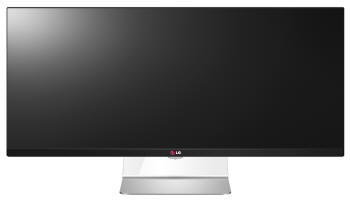
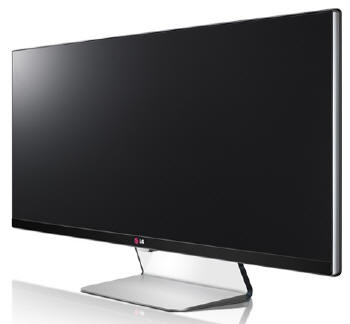
Above:
front views of the screen. Click for larger versions
The 34UM95 comes in a black and silver
design. The bezel and edges to the screen are black (glossy bezel), and
there is a shiny silver trim around the entire edge. There is an LG logo
in the middle of the bottom bezel, but no other model names or writing on
the edges at all. You immediately notice just how wide this screen is when
you first unpack it. It really is a massive display and the 21:9 aspect
ratio takes a bit of getting used to when coming from a 16:9 or 16:10
format display.
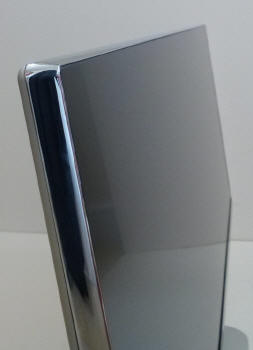
Above:
view of silver trim. Click for larger version
The silver trim around the edge of the
screen is shown above and gives the screen a premium feel, making it feel
a bit like a TV in fact in style.
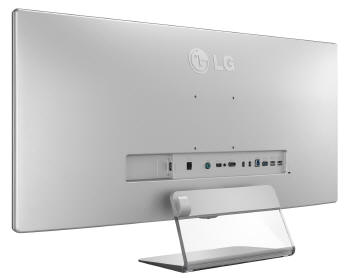
Above:
rear view of the screen. Click for larger version
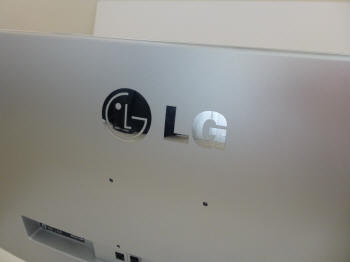
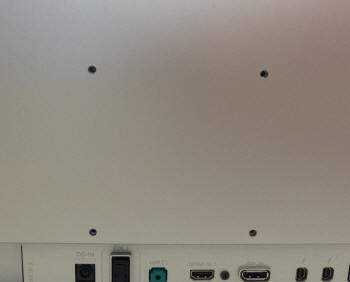
Above:
rear views of the screen showing LG logo and VESA mounting holes. Click for larger versions
The back of the screen is well rounded and
looks sleek as shown above. There is a shiny silver LG logo at the top,
and VESA 100 mounting holes also if you want to wall or arm-mount the
display.

The edges of the screen (sides and top) are
made up of a black panel border which measures about 11mm in thickness,
and a shiny silver trim edge which measures about 1.5mm. This gives LG
it's "cinema screen bezel" design but don't be fooled by any marketing
suggesting the bezel is only a couple of mm thick. You need to account for
the panel border which is where the image stops. The panel border
has the same AG coating as the actual visible screen area. Along the
bottom edge of the screen is a more traditional glossy black plastic
bezel. This is about 18mm thick, and there is then a smaller 5mm panel
border before the image starts. Again the shiny silver edge continues all
around the screen so there is another ~1.5mm or so of visible silver edge
as well. All in all the "edges" around the screen look thin and attractive
and the shiny silver trim gives a nice premium design feel as well.
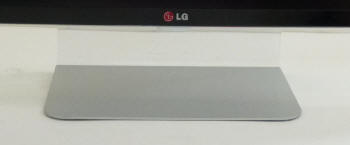
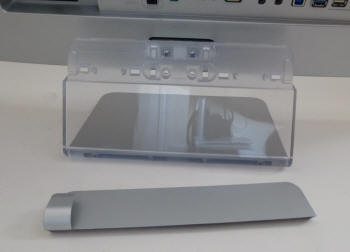
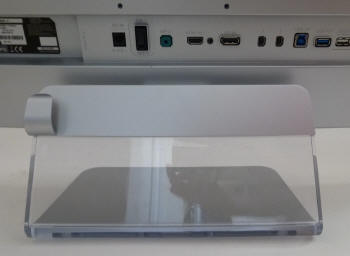
Above:
showing stand and attachment on the back of the screen. Click for larger versions
The base of the stand is a fixed folded
shape as shown above. It needs to be screwed onto the back of the screen
using the provided screws (x2). You can actually select two slightly
different heights on the back which gives you a small choice of the
vertical height of the screen. Note the two sets of holes on the plastic
stand in the photos above. Even at the highest connection though the
screen still sits pretty low on the desk. The bottom edge of the screen is
~85mm from the top edge of the desk when connected in this way. The back
of the stand is a clear plastic which is dubbed "Crystal Float" by LG. It
is designed to make the screen look like it is floating in the air. In
reality, the screen sits low on the desk so a lot of people may not be
able to see the plastic section anyway. Certainly from our normal viewing
position / chair height we couldn't see the back of the stand. Being clear
as well it means that you can see the cables behind it as well so it's a
bit debateable whether this feature is a good thing or not. There is a
plastic trim section provided to cover up the screw connections as shown
in the photos above, which features a cable clip to try and steer the
cables out the way if you want.
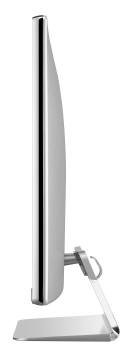
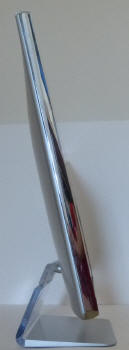
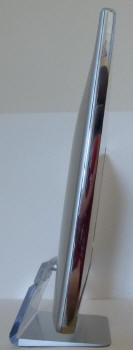
Above:
side views of the screen showing full tilt range. Click for larger versions
From a side view the screen offers an
attractive and thin profile as you can see above. There is a basic tilt
function offered by the stand only. This is easy to move and offers smooth
adjustments. Unfortunately no other ergonomic adjustments like height,
swivel or rotate are offered here so the stand is very limited.
A summary of the screens ergonomic adjustments
is shown below:
|
Function |
Range |
Smoothness |
Ease of Use |
|
Tilt |
Yes |
Smooth |
Easy |
|
Height |
n/a |
- |
- |
|
Swivel |
n/a |
- |
- |
|
Rotate |
n/a |
- |
- |
|
Overall |
Limited adjustments with only
tilt available. Smooth to use but the screen is a bit wobbly. |
The materials were of a very good standard and
build quality felt sturdy and strong. There was
no audible buzzing noise from the screen even when conducting specific
tests which can often identify buzzing issues.
The whole screen remained very cool even during prolonged use as well which
was pleasing.


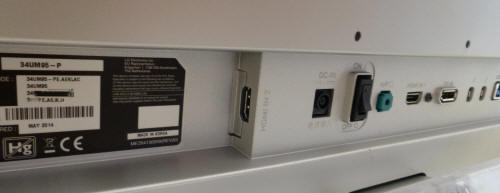
Above:
rear views of the screen showing connections. Click for larger versions
The back of the screen features all the
connection options. You will note there is an HDMI connection on the side of
this section, shown as the most left hand connection in the photo above (HDMI
2 input). There are then other video and audio connections, a port for the
external power supply and then the USB ports on the far right.
By the way the sample we tested is a Rev 01,
manufactured May 2014.

OSD Menu

Above: joystick controller on bottom edge of the screen
The OSD menu is accessed and controlled through a
single joystick controller located on the middle of the bottom edge of the screen. This joystick is pressable as well and controls
the whole menu.

Pressing the joystick left or right pops up a
quick access menu for the volume control as shown above.
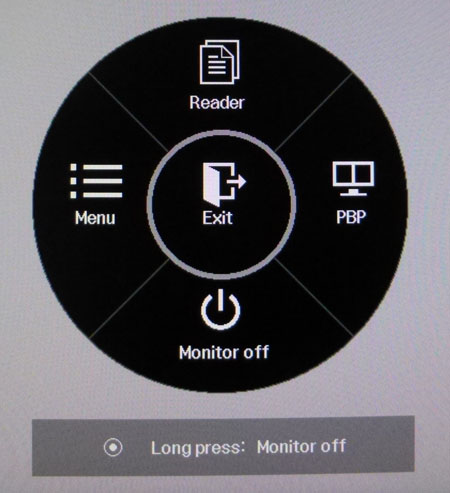
Pressing the joystick forward or backward, or
pressing the button in pops up the launch menu shown above. It probably takes
about 1 second to bring up this menu after pressing the button so it feels like
it's pretty un-responsive. From here you have quick access to the Reader modes
and PbP menu (which just takes you to that section in the main OSD menu). You
can also enter the main menu by pressing left.
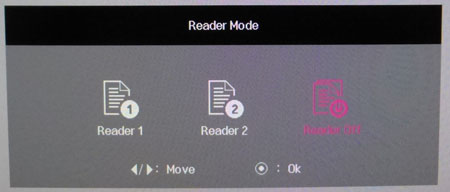
The 'Reader mode' menu is shown above with 2
presets offered if you want to use them. It would have been useful if you could
change the quick access options when you first pop up this menu, as the PbP and
Reader sections aren't of much use to us personally.
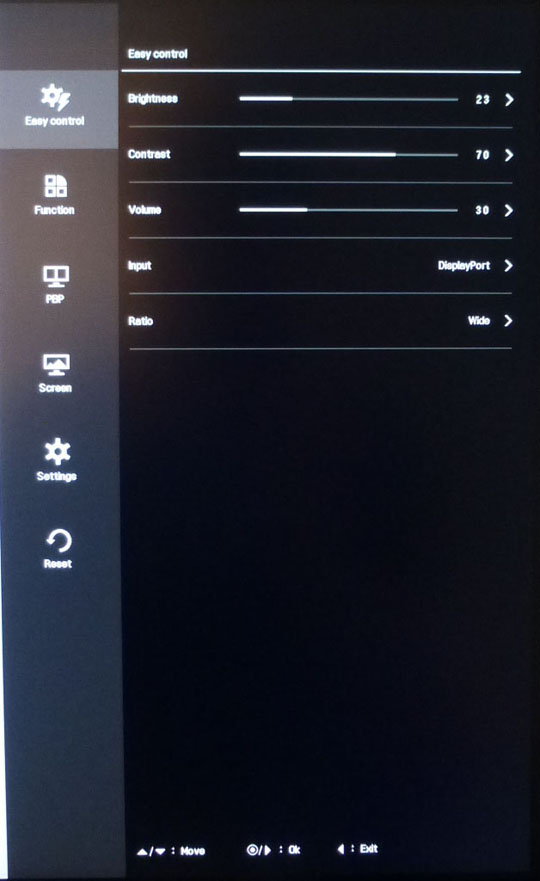
Pressing the left direction pops up the main OSD
menu on the far right hand side of the screen. Again it takes about a second to
bring up the menu after the joystick press so it feels a bit unresponsive again.
The OSD menu is really big, filling up the whole screen vertically from top to
bottom and a quarter of the screen horizontally. Excuse the large photos in this
section!
Once you're in the main menu the controls are
thankfully responsive as they should be, allowing you to quite easily navigate
through the options. The menu is split into 6 sections down the left hand edge,
and the options available in each section are shown on the right. The first
'Easy control' section gives you access to the brightness and contrast settings,
and also you can change the aspect ratio in this section. There are options here
for Wide, original, Cinema 1, Cinema 2 and 1:1 pixel mapping.
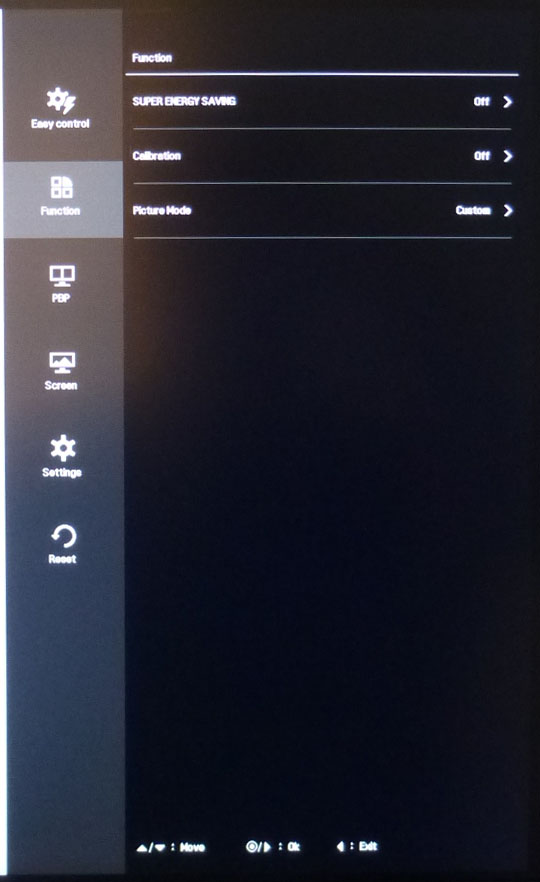
Scrolling down to the 'Function' section gives you
access to the preset energy saving modes, an option to enable or disable the
hardware
calibration if you've done one, and also choose from a few preset picture
modes.
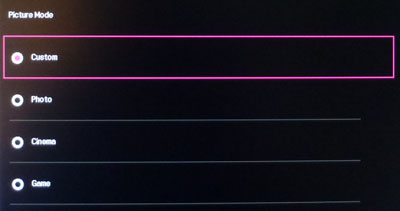
The picture mode options are shown above.
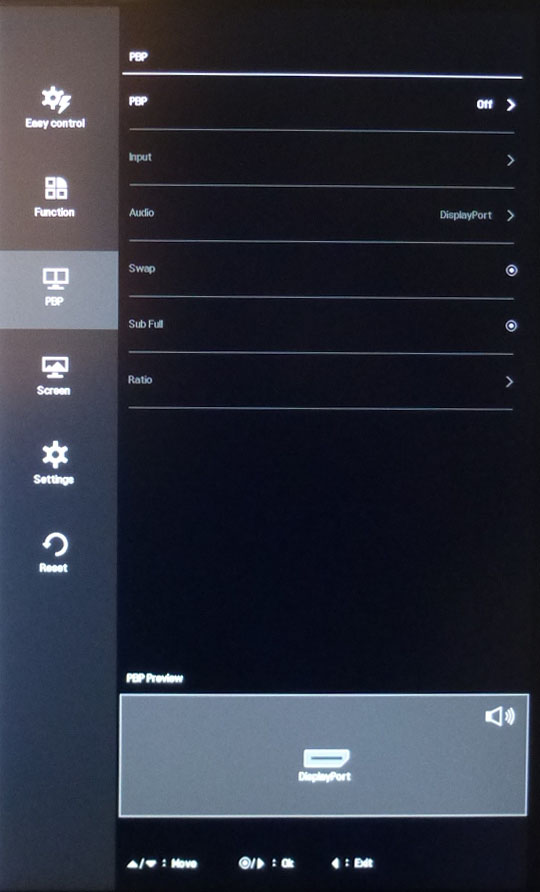
The third section is the Picture By Picture menu
as shown above if you have more than 1 device connected and want to make the
most of split screen working on the large 34" screen.
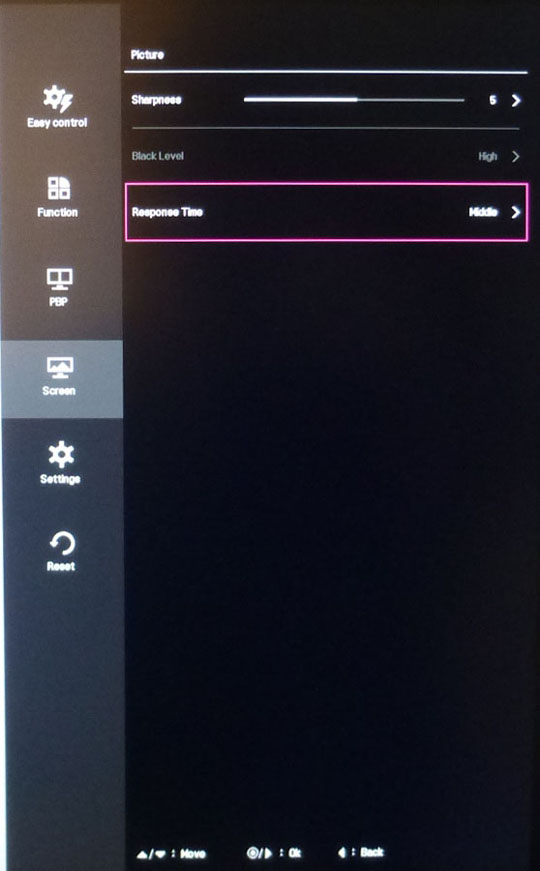
The fourth 'Screen' section gives you two options,
one for 'Picture' and one for 'Color'. In the 'Picture' sub-section there are a
couple of options, perhaps most importantly the 'Response Time' option to
control the level of overdrive being used. We will
test that later
on in the review.
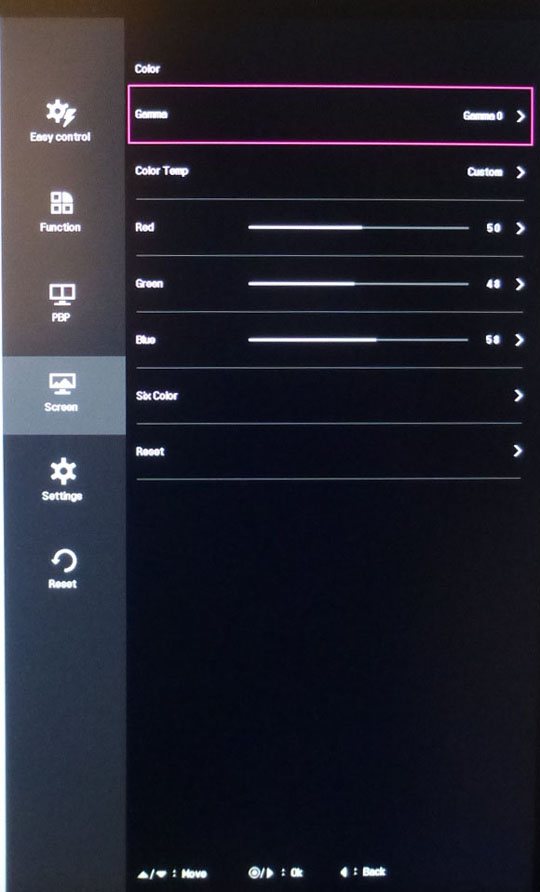
The 'Color' subsection of the 'Screen' part of the
menu gives you a wide range of options. You can change the preset
gamma and colour
temperature modes here and also change the RGB levels for manual
calibration.
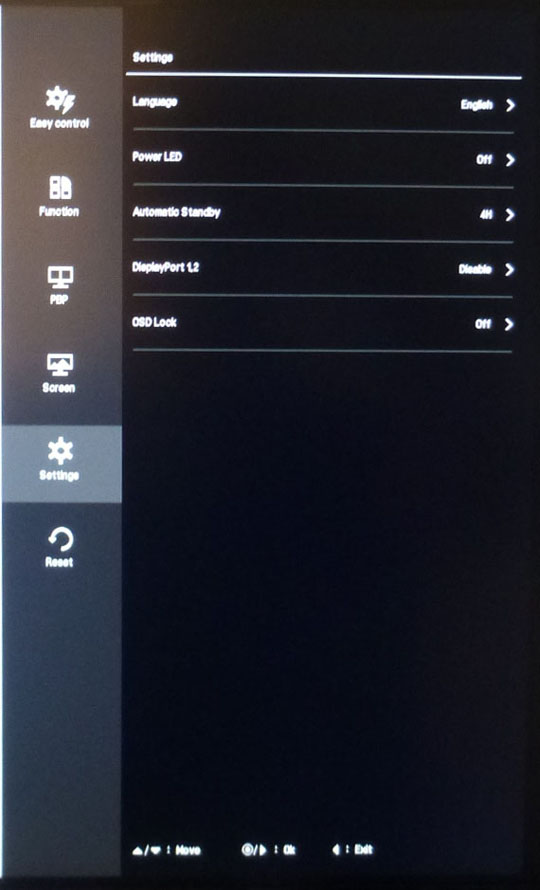
The fifth 'settings' section gives you control
over a few things related to the monitor as shown above. We were disappointed
that there was not an option to choose how long the OSD stays visible without
action before it disappears, as it doesn't seem to stay there very long and made
testing a bit of a pain. We had to keep going through all the steps to get back
into a section we wanted to play with each time, and the whole thing was a bit
cumbersome.
Below that is an option to reset the screen to
default settings.
Overall the menu offered a good set of options. We
found navigation a slow and quite painful experience though to be honest. The
joystick is fairly intuitive to use, but having to press forward/backward to pop
up the quick launch menu (with a 1 second delay), then press left to bring up
the main OSD (with another 1 second delay) was frustrating. You couldn't change
the menu time out either, so it disappeared quite often while we were testing
different options, forcing us to go through the whole thing again. It didn't
remember where you last were either so you had to start again. The software was
very large and a bit clunky we felt as well. LG have tried to make things simple
with a single joystick, but it all needs to be a lot easier to navigate we
think.

Power Consumption
In terms of power consumption the manufacturer
lists "normal" usage of 80.0W and 1.2W in standby. We carried out our normal tests to
establish its power consumption ourselves.
|
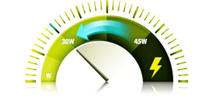 |
|
State and Brightness
Setting |
Manufacturer Spec (W) |
Measured Power Usage
(W) |
|
Default (70%) |
80.0 |
58.9 |
|
Calibrated (hardware LUT) |
- |
42.0 |
|
Maximum Brightness (100%) |
- |
67.0 |
|
Minimum Brightness (0%) |
- |
32.8 |
|
Standby |
1.2 |
1.0 |
|
We tested this ourselves and found that out of the
box the screen used 58.9W at the default 70% brightness setting. Once calibrated the screen reached
42.0W consumption, and in standby it
used only 1.0W. We have plotted these results below compared with other screens
we have tested. The consumption is comparable actually to the GB-r-LED backlit
displays (Dell U3014, U2713H etc), and uses a bit more than most W-LED
backlights. This is presumably down to the monitors size and features.


Panel and Backlighting
|
Panel Manufacturer |
LG.Display |
Colour Palette |
1.07 billion |
|
Panel Technology |
AH-IPS |
Colour Depth |
8-bit + FRC |
|
Panel Module |
LM340UW1-SSA1 |
Colour space |
Standard gamut |
|
Backlighting Type |
W-LED |
Colour space coverage (%) |
99% sRGB, ~72% NTSC |
Panel Part and Colour Depth
The LG 34UM95 utilises a
LG.Display LM340UW1-SSA1 AH-IPS panel which is
capable of producing 1.07 billion colours. This is achieved through an 8-bit grey scale and
additional Frame Rate Control (FRC), providing an 8-bit+FRC panel. This 10-bit
support is available when using the DisplayPort interface only according to the
spec sheet.
Keep in mind whether this is practically useable and whether you're ever going
to truly use that colour depth. You need to have a full 10-bit end to end
workflow to take advantage of it which is still quite expensive to achieve and
rare in the market, certainly for your average user. This includes relevant
applications and graphics cards as well, so to many people this 10-bit support
might be irrelevant.
Screen
Coating
The
screen coating on the 34UM95 is a light anti-glare (AG) offering. It
isn't a semi-glossy coating, but it is light as seen on other modern IPS type panels. Thankfully it
isn't a heavily grainy coating like some old IPS panels feature. It retains its anti-glare properties to
avoid too many unwanted reflections of a full glossy coating, but does not
produce an too grainy or dirty an image that some thicker AG coatings can. There
were no cross-hatching patterns visible on the coating.
Backlight Type and Colour Gamut
The screen uses a White-LED (W-LED) backlight unit
which has become very popular in today's market. This helps reduce power
consumption compared with older CCFL backlight units and brings about some
environmental benefits as well. The W-LED unit offers a standard colour gamut
which is approximately equal to the sRGB colour space (99% sRGB quoted).
Anyone wanting to work with wider colour spaces would need to consider wide
gamut CCFL screens or the newer range of GB-r-LED type displays available
now. If
you want to read more about colour spaces and gamut then please have a read of
our
detailed article.
Backlight
Dimming and Flicker
We tested the screen to establish the methods used
to control backlight dimming. Our in depth article talks in more details about a
common method used for this which is called
Pulse Width Modulation (PWM). This in itself gives cause for concern to some
users who have experienced eye strain, headaches and other symptoms as a result
of the flickering backlight caused by this technology. We use a photosensor +
oscilloscope system to measure backlight dimming control
with a high level of accuracy and ease. These tests allow us to establish
1) Whether PWM is being used to control the
backlight
2) The frequency and other characteristics at which this operates, if it is used
3) Whether a flicker may be introduced or potentially noticeable at certain
settings
If PWM is used for backlight dimming, the higher
the frequency, the less likely you are to see artefacts and flicker. The duty
cycle (the time for which the backlight is on) is also important and the shorter
the duty cycle, the more potential there is that you may see flicker. The other
factor which can influence flicker is the amplitude of the PWM, measuring the
difference in brightness output between the 'on' and 'off' states. Please
remember that not every user would notice a flicker from a backlight using PWM,
but it is something to be wary of. It is also a hard thing to quantify as it is
very subjective when talking about whether a user may or may not experience the
side effects.
100% 50%
0%
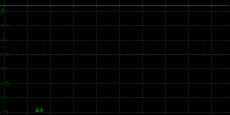
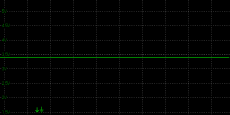
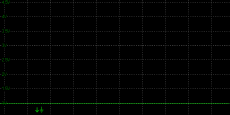
Above scale = 1
horizontal grid = 1ms
LG specifically market this screen as being
Flicker Safe, a trend we hope more manufacturers adopt. At all brightness settings a constant voltage is
applied to the backlight and there is no Pulse Width Modulation used. Instead
the screen uses a Direct Current (DC) method and we can confirm that the screen
is indeed flicker free as advertised.
|
Pulse Width
Modulation Used |
No |
|
Cycling
Frequency |
n/a |
|
Possible
Flicker at |
|
|
100% Brightness |
No |
|
50% Brightness |
No |
|
0% Brightness |
No |
For an up to date list of all flicker-free (PWM free) monitors please see our
Flicker Free Monitor Database.

Contrast
Stability and Brightness
We wanted to see how much variance there was in
the screens contrast as we adjusted the monitor setting for brightness.
In theory, brightness and contrast are two independent parameters, and good
contrast is a requirement regardless of the brightness adjustment.
Unfortunately, such is not always the case in practice. We recorded the
screens luminance and black depth at various OSD brightness settings, and
calculated the contrast ratio from there. Graphics card settings were left at
default with no ICC profile or calibration active. Tests were made using an
X-rite i1 Display Pro colorimeter. It should be noted that we used the
BasICColor calibration software here to record these, and so luminance at
default settings may vary a little from the LaCie Blue Eye Pro report.
We turned the
Super Energy Saving Mode
to off for these tests since it limits the brightness adjustment range when
enabled for specific power consumption profiles.
|
OSD
Brightness |
Luminance
(cd/m2) |
Black
Point (cd/m2) |
Contrast
Ratio
( x:1) |
|
100 |
292.98 |
0.29 |
1010 |
|
90 |
273.43 |
0.27 |
1013 |
|
80 |
254.45 |
0.25 |
1018 |
|
70 |
233.57 |
0.23 |
1016 |
|
60 |
212.70 |
0.21 |
1013 |
|
50 |
190.63 |
0.19 |
1003 |
|
40 |
165.88 |
0.17 |
976 |
|
30 |
141.02 |
0.14 |
1007 |
|
20 |
112.85 |
0.11 |
1026 |
|
10 |
84.66 |
0.09 |
941 |
|
0 |
54.38 |
0.06 |
906 |
|
Total Luminance Adjustment Range
(cd/m2) |
238.60 |
Brightness OSD setting controls backlight? |
 |
|
Total Black Point
Adjustment Range (cd/m2) |
0.23 |
|
Average Static Contrast Ratio |
994:1 |
PWM Free? |
 |
|
Recommended OSD setting
for 120 cd/m2 |
22 |
The brightness control gave us a very good range
of adjustment. At the top end the maximum luminance reached 293
cd/m2 which was
high, and only slightly shy of the specified maximum brightness of 320 cd/m2
from the manufacturer. There was a decent 239 cd/m2 adjustment range
in total, and so at the minimum setting you could reach down to a low luminance
of 54 cd/m2. This should be adequate for
those wanting to work in darkened room conditions with low ambient light. A
setting of 22 in the OSD menu should return you a
luminance of around 120 cd/m2 at default settings.
It should be noted that the
brightness regulation is controlled without the need of
Pulse Width Modulation using a Direct Current (DC) method for all brightness settings
between 100 and 0% and so the screen is flicker free.
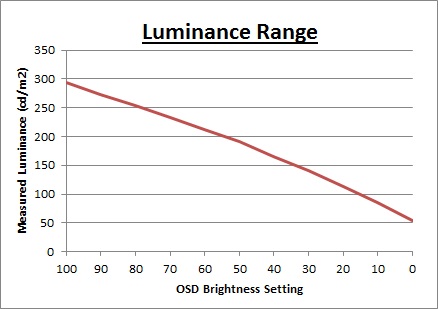
We have plotted the
luminance trend on the graph above. The screen behaves as it should in this
regard, with a reduction in the luminance output of the screen controlled by the
reduction in the OSD brightness setting. This is pretty much a linear relationship
with a slightly steeper curve from 50% and below.
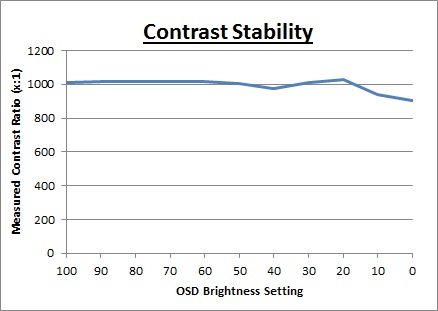
The average contrast ratio of
the screen was very good for an IPS panel with an average of 994:1. This was
pretty stable across the brightness adjustment range as shown above although at
the lowest brightness settings below 20% the contrast seemed to drop slightly to
around 906:1 in the most extreme case (0% brightness). This dragged the average
down from what otherwise would have been around 1015:1.

Testing
Methodology
An
important thing to consider for most users is how a screen will perform out of
the box and with some basic manual adjustments. Since most users won't have
access to hardware colorimeter tools, it is important to understand how the
screen is going to perform in terms of colour accuracy for the average user.
We restored our graphics card to default settings and disabled any previously active
ICC profiles and gamma corrections. The screen was tested at default factory settings using the DVI interface, and analysed using
an
X-rite i1
Pro Spectrophotometer (not to be confused with the i1 Display Pro
colorimeter) combined with
LaCie's Blue Eye Pro software suite. An X-rite i1 Display Pro colorimeter was
also used to verify the black point and contrast ratio since the i1 Pro
spectrophotometer is less
reliable at the darker end.
Targets for these tests are as follows:
-
CIE Diagram - validates the colour space
covered by the monitors backlighting in a 2D view, with the black triangle representing the
displays gamut, and other reference colour spaces shown for comparison
-
Gamma - we aim for 2.2 which is the default
for computer monitors
-
Colour temperature / white point - we aim
for 6500k which is the temperature of daylight
-
Luminance - we aim for 120
cd/m2, which is
the recommended luminance for LCD monitors in normal lighting conditions
-
Black depth - we aim
for as low as possible to maximise shadow detail and to offer us the best
contrast ratio
-
Contrast ratio - we aim
for as high as possible. Any dynamic contrast ratio controls are turned off here
if present
-
dE average / maximum -
as low as possible.
If DeltaE >3, the color displayed is significantly different from the
theoretical one, meaning that the difference will be perceptible to the
viewer.
If DeltaE <2, LaCie considers the calibration a success; there remains a
slight difference, but it is barely undetectable.
If DeltaE < 1, the color fidelity is excellent.

Default Performance and
Setup
The LG 34UM95 comes factory calibrated, showing
LG's focus on providing a high quality product suitable for colour critical
work. There is no specific preset mode specified in the documentation or on the
factory calibration report, so we can only assume that this applies to the
default settings of the screen. The screen is packaged with a calibration report
unique to your screen, confirming the targets set and met during that process.
Here they have factory calibrated to a 2.2 gamma, 6500k white point and with a
dE colour accuracy of <5. A copy of the calibration report from our unit is
provided below for reference:
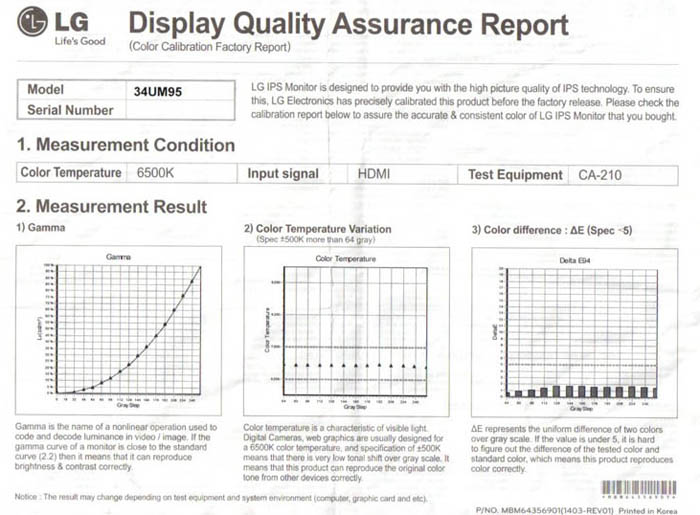
Default settings of the screen were as follows:
|
Monitor OSD Option |
Default Settings |
|
Brightness |
70 |
|
Contrast |
70 |
|
Picture Mode |
Custom |
|
Gamma |
Gamma 1 |
|
Color Temp |
Custom |
|
RGB |
50, 50, 50 |

LG 34UM95 - Default Factory Settings / Factory Calibration




|
|
Default Settings |
|
luminance (cd/m2) |
243 |
|
Black Point (cd/m2) |
0.24 |
|
Contrast Ratio |
1016:1 |
Initially out of the box the screen was bright and was set at
a default 70% brightness setting. Colour balance felt
good, and you could tell it was a standard gamut screen. We went ahead and measured the default state with
the i1 Pro.
The
CIE diagram on the left of the image confirms that the monitors colour gamut
(black triangle) is roughly equal to
the sRGB colour space. There is some minor over-coverage in some shades, with green
and blue
being a little wider than the sRGB space but not by anything significant.
Default gamma was recorded at 2.1 average, leaving it with a small 4% deviance
from the target of 2.2 which was reasonable. White point was measured at 6326k being close to the target of 6500k which was good and with
only a 3% deviance.
Luminance was recorded at a bright 243
cd/m2 which is
too high for prolonged general use. The screen was set at a default 70%
brightness in the OSD menu but that is easy to change of course to reach a more
comfortable setting without impacting any other aspect of the setup. The black depth was 0.24 cd/m2 at this default
brightness setting, giving us a very good (for a IPS panel) static contrast ratio of
1016:1.
Colour accuracy was pretty good out of the box
with a default dE average of 2.0, and maximum of 4.9. Testing the screen with
various gradients showed smooth transitions with no sign of any banding
thankfully. There was some gradation evident as you will see from most monitors.
Overall the default setup was good enough, with the gamma and white point being
reasonable. Looks like the factory calibration does provide a reasonable setup
for the screen which should be fine for most casual users.

Colour Temperatures and Gamma
The 34UM95 features a range of 'color temp'
modes within the OSD menu as shown in the below screen shots. There are also 3
pre-defined gamma modes available to choose from. We measured the screen
with the X-rite i1 Pro spectrophotometer in each of these modes to establish
their colour temperature / white point. We also tested the average gamma in each mode,
while color temp was left at the default 'custom' setting. All other settings were left at factory defaults and no
ICC profile was active. The results are recorded below:
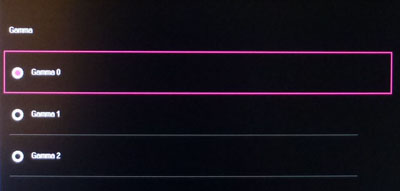
Gamma
|
Gamma Mode |
Average Gamma |
Deviance from
2.2 Gamma |
|
0 |
2.2 |
2% |
|
1 |
2.1 |
4% |
|
2 |
1.9 |
15% |
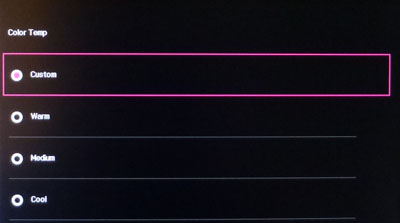
Colour Temperature
|
Color Temp
Mode |
Measured
White point (k) |
|
Custom |
6160 |
|
Warm |
6163 |
|
Medium |
7707 |
|
Cool |
8940 |
The gamma mode of 0 actually seemed slightly
better than the default mode of 1, bringing us slightly closer to the 2.2
target. There was only a minor 2% deviance when using gamma 0 as the preferred
setting, so this might make some minor improvements to your setup out of the
box. The 'custom' color temp mode was basically the same as the 'warm' setting
out of the box, being slightly too warm at 6160k. The 'medium' setting was
noticeably cooler than the default setting, and the 'cool' setting was even
more so. Both the medium and cool settings looked very blue. In the 'custom'
mode allows you to adjust the RGB balance for calibration to bring white point
nearer to your target (in our case 6500k).

Software Calibration
We used the
X-rite i1 Pro spectrophotometer combined with the LaCie Blue Eye Pro
software package to achieve these results and reports. An X-rite i1 Display Pro
colorimeter was used to validate the black depth and contrast
ratios due to lower end limitations of the i1 Pro device.
|
Monitor OSD Option |
Calibrated Settings |
|
Brightness |
21 |
|
Contrast |
70 |
|
Picture Mode |
Custom |
|
Gamma |
Gamma 0 |
|
Color Temp |
Custom |
|
RGB |
50, 48, 58 |

LG 34UM95 - Software Calibrated Settings
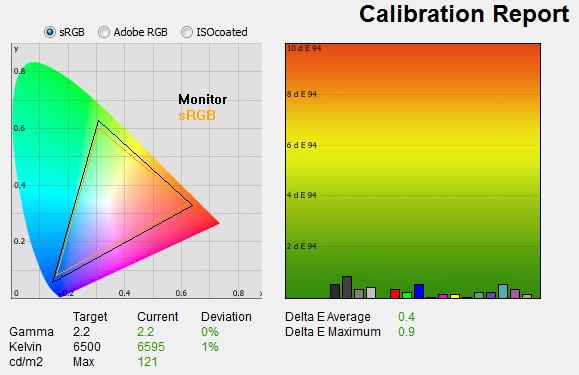
|
|
Software Calibrated Settings |
|
luminance (cd/m2) |
121 |
|
Black Point (cd/m2) |
0.11 |
|
Contrast Ratio |
1064:1 |
We changed to the gamma 0 mode to start with as
we'd found that it gave us a starting point closer to the required 2.2 target
(2% deviance out of the box). The 'custom' color temp mode would give us access
to the RGB channels as well, where we had to increase the blue gain to
counteract the slightly warm default setup. All these OSD
changes allowed us to obtain an
optimum hardware starting point and setup before software level changes would be
made at the graphics card level. We left the LaCie software to calibrate
to "max" brightness which would just retain the luminance of whatever brightness
we'd set the screen to, and would not in any way try and alter the luminance at
the graphics card level, which can reduce contrast ratio. These adjustments
before profiling the screen would help preserve tonal values and limit
banding issues. After this we let the software carry out the LUT adjustments and create an
ICC profile.
Average gamma was now corrected to 2.2 average,
correcting the 2% deviance we'd seen out of the box (gamma mode 0). The
white point was also corrected very close to the target, now measured at 6595k, correcting
most of the minor 3% deviance out
of the box. Luminance had been improved thanks to the adjustment to the
brightness control and was now being measured at 121
cd/m2. This
left us a black depth of 0.11 cd/m2 and maintained a very good static contrast ratio
(for an IPS panel) of
1064:1. Colour accuracy of the resulting
profile was very good, with dE average of 0.4 and maximum of 0.9. LaCie would
consider colour fidelity to be very good overall.
Testing the screen with various colour gradients
showed mostly smooth transitions. There was some slight gradation in darker tones
but no banding introduced due to the adjustments to the
graphics card LUT from the profilation of the screen which was pleasing.
You can use our settings and
try our calibrated ICC profile if you wish, which are available in
our ICC profile database. Keep in mind that results will vary from one
screen to another and from one computer / graphics card to another.

Hardware
Calibration
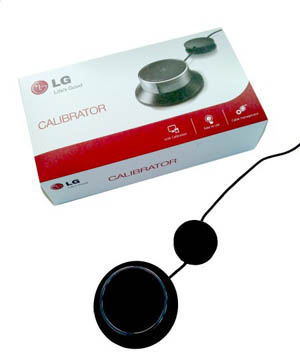
The 34UM95 features support for hardware
calibration, allowing the user to directly access the internal LUT and make
adjustments to the screen at a hardware level. This requires two things to make
this possible: 1) a compatible calibration device (not provided) and 2) LG's
"True Color" calibration software package. True Colour Finder is only compatible
with Windows XP/7/8 by DisplayPort; Windows 7/8 by Thunderbolt; or New Mac Pro
by DisplayPort/Thunderbolt. Thankfully LG have decided to allow their software
to be downloaded for free, and for it to work with a wide range of existing
calibration tools on the market. According to the user guide for the software
the following devices are supported:
Supported Calibrators / Measurement Devices
-
-
LG Electronics
-
-
X-rite Inc
-
-
ColorMunki photo
-
Version 1.1.1
-
-
ColorMunki design
-
Version 1.1.1
-
-
i1DISPLAY Pro(i1Display3)
-
Version 0.4.7.2
-
-
-
Data Color Manufacturer
-
-
Spyder3
-
Version 1.2.2
-
-
Spyder4
-
Version 1.0.0.1
You will note that LG also provide their own
calibrator tool (pictured above), the so-called "LG Calibrator" (part ACB8300). We will test this
in a moment, but it was pleasing to see that popular devices were also
compatible. Note that we also tried our i1 Pro spectrophotometer (v1) which was
detected by the software as the i1 Pro 2. This suggests that maybe the i1 Pro 2
is a compatible device as well, although not listed in the system requirements
spec LG provide. The i1 Pro (v1) didn't seem to work though sadly, and the
software just gave a "device not found" message when we tried.
We downloaded the latest version of the Color
Finder software from LG's website (72Mb, v 3.1.3). The monitor must be connected
to the PC using a USB cable for the hardware calibration to function or via
Thunderbolt. Oddly
there is no USB cable provided in the box with the 34UM95, although they are
very cheap to pick up from most places.
Note about hardware calibration: We did
find a bit of a firmware bug when enabling and disabling the hardware
calibration feature in the OSD, or carrying out a hardware calibration from new.
It seems to restore the Response Time behaviour to the performance as if
Response Time was set to "off", even if in the OSD it still reflected another
setting. We're not sure why this is, but if you carry out a hardware calibration
or turn it on or off, we recommend just going into the Response Time setting,
turning it on to a random setting and activating it, and then returning back to
your preferred Response Time setting. That seems to put it back into the desired
mode.
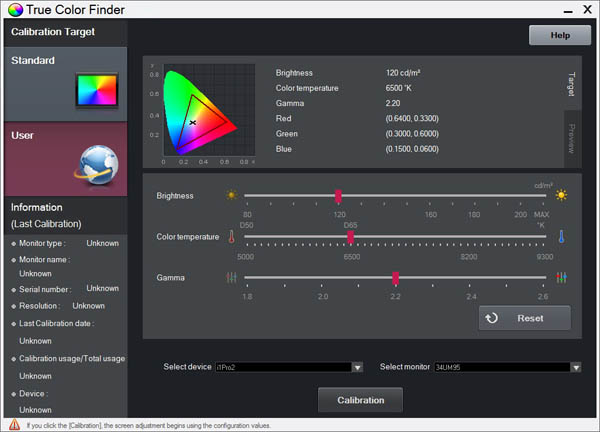
Loading up the software presents you with the
above interface. You can select from 2 modes, the 'standard' mode where white
point and gamma are preset (6500k and 2.2 respectively), or a 'user' mode where
you can change these if you like. In both modes you can easily change the
desired brightness target using the slider. The top of the screen confirms your targets
for calibration and you can simply press 'calibration' at the bottom then to
progress into the fully automated process.
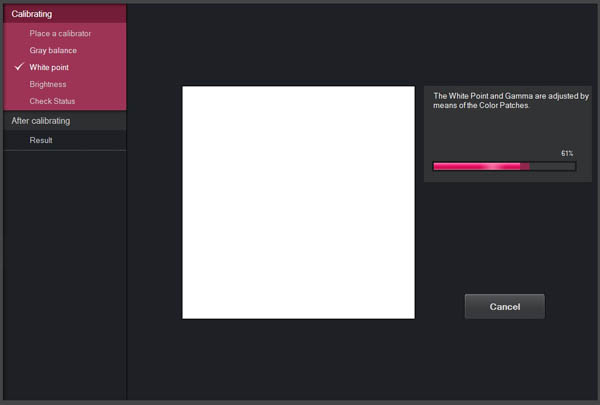
The actual calibration process provides you an
area on the screen where you need to place your calibration device. It then goes
through a series of automatic readings and adjustments to calibrate the screen
for you. You don't have to change anything in the OSD at all, and in fact once
you've started this process most options for colour/brightness/contrast
adjustments are greyed out in the OSD menu. The screen enters the 'calibration =
on' setting as well to signify that you have hardware calibrated the screen.
With the whole process being automatic, it's very easy to use. Using the i1
Display Pro first of all as our calibration device, the calibration took around
5 min 45 sec to complete.
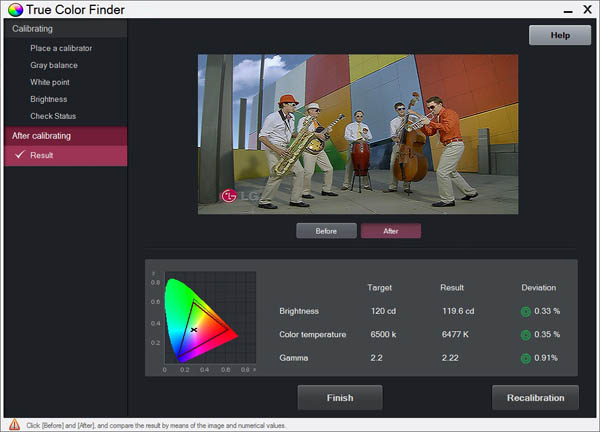
At the end of the process you are presented with a
confirmation screen as shown above. There are no further reporting or validation
features available in the software, just this simple summary. Checking the
graphics card confirms no active ICC profile, and so all settings have been made
to, and stored in the monitors hardware LUT. Clicking 'finish' just exits the
software.
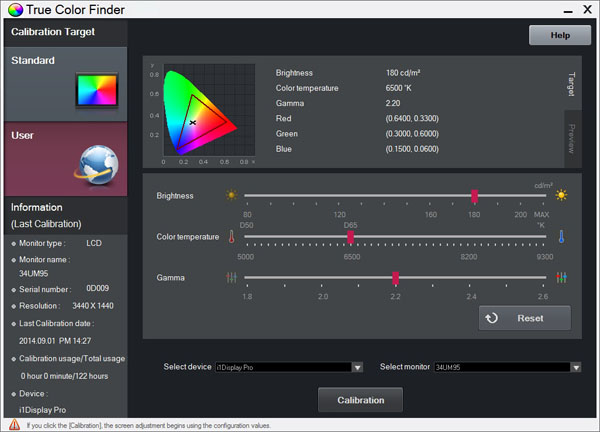
If you enter back into the True Color software the
left hand side now confirms your last calibrated details as shown above. You can
then do another calibration to over-write the saved calibration if you want.

LG 34UM95 - Hardware Calibration, i1 Display Pro
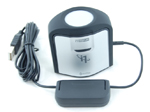
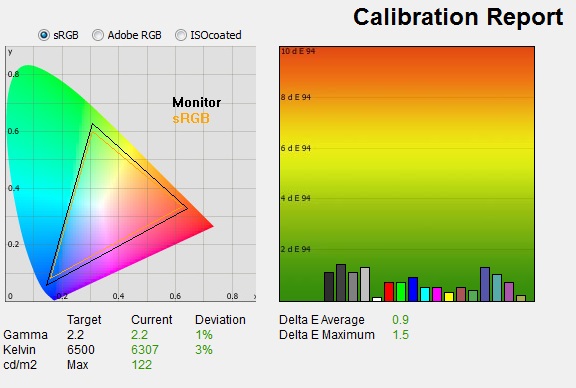
|
|
Calibrated Settings,
Hardware calibration |
|
luminance (cd/m2) |
122 |
|
Black Point (cd/m2) |
0.11 |
|
Contrast Ratio |
1064:1 |
We wanted to validate the calibrated state a
little further. We had calibrated the screen using the LG True Color software
and the X-rite i1 Display Pro device. The resulting validation was carried out
using the LaCie Blue Eye Pro software and our i1 Pro spectrophotometer. The
results were pleasing overall. Gamma and white point targets had been met pretty
well, although there was some slight deviance in the white point here with it
being a little too warm. This difference is down to the different devices and
software being used, but it's interesting just to check the hardware calibration
results using a "reference" point anyway. Colour accuracy was very good with dE
average of 0.9 measured. Contrast ratio remained strong as it had at default
monitor settings with a contrast ratio of 1064:1 being recorded. All in all, the
True Color software seemed to have done a very good job of calibrating the
screen as intended. One quibble however is that with the OSD brightness control
now locked, you cannot change even a basic setting like that without having to
completely re-run the calibration again. It would have been nice if you could
hardware calibrate the screen to reach desired gamma and white point levels and
return good colour accuracy, but
still had access to manually adjust the brightness if you wanted to. After all,
different uses might require access to that setting, and changing it wouldn't
affect other aspects of the calibration.

LG 34UM95 - Hardware Calibration, LG Calibrator
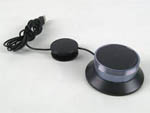
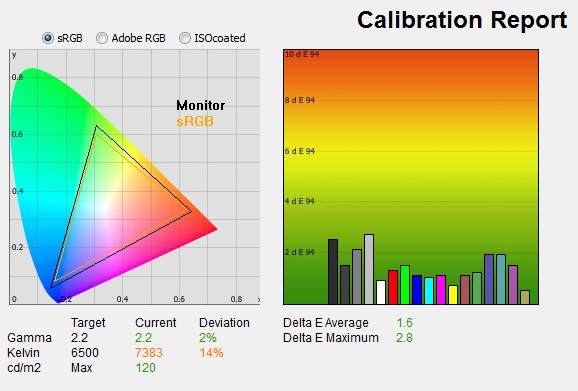
|
|
Calibrated Settings,
Hardware calibration |
|
luminance (cd/m2) |
120 |
|
Black Point (cd/m2) |
0.13 |
|
Contrast Ratio |
907:1 |
We re-ran another hardware calibration, this time
using LG's calibrator device. The whole process was a little faster and only
took 5 min 23 sec to complete this time. The LG True Color software confirmed
the targets had been met well (2.2 gamma, 6500k white point, 120 cd/m2
brightness). We again validated these results using our i1 Pro and the LaCie
Blue Eye Pro software.
Here, results were not as pleasing as when we'd
hardware calibrated with the X-rite i1 Display Pro. The main issue seemed to be
the white point, which was now too cool and although the target had been set to
6500k, it had ended up being 7383k. This suggests maybe the LG Calibrator has a
hard time correcting the white point, or perhaps doesn't have the necessary
correction filters to read the white point of the W-LED backlight properly?
Other areas had been met pretty well as before, although colour accuracy was a
little worse (dE average of 1.6 instead of 0.9 now), and contrast ratio was
lower also (907:1 instead of 1064:1).
The LG device is pretty low cost, available for
£29.99 from Overclockers.co.uk but it didn't seem to offer as reliable a
result as using a higher-end third party device. It seems it has trouble reading
the white point of the W-LED backlight which is common to a lot of colorimeter
tools as they are commonly designed to work with standard CCFL backlighting.
They often have trouble reading the white point of wide gamut or LED backlights.
If you have an existing colorimeter then at least
the True Color software provides support for most popular and recent
colorimeters which is pleasing. There's no need to specifically buy the LG
device if you want to hardware calibrate the screen. If you want optimum results
then you would probably be better buying a device like the i1 Display Pro,
although cost is higher than the LG device. It should be noted that the LG True
Color software doesn't work with any non-LG screens, and the LG calibrator
doesn't appear to work with third party software packages either. So you can use
it for this and other compatible LG screens only. Again, if you want a device to
use with other displays you'd be better getting something separate.

Calibration
Performance Comparisons
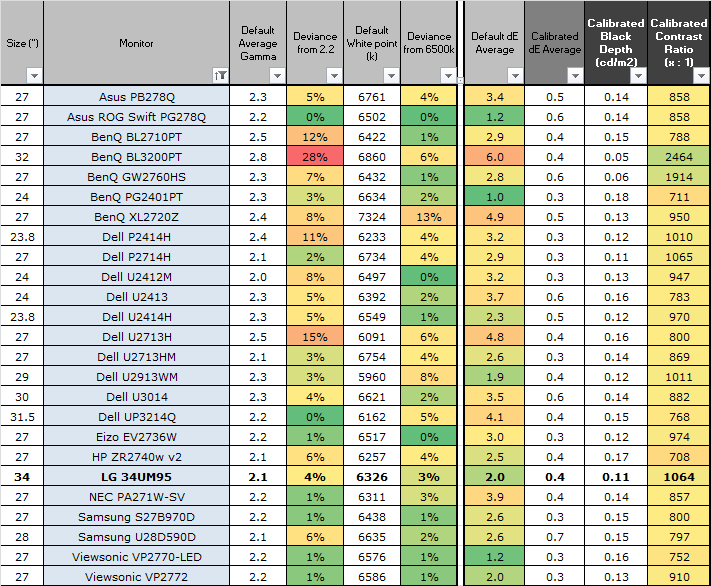
The comparisons made in this section try to give
you a better view of how each screen performs, particularly out of the box which
is what is going to matter to most consumers. When comparing the default factory
settings for each monitor it is important to take into account several
measurement areas - gamma, white point and colour accuracy. There's no point
having a low dE colour accuracy figure if the gamma curve is way off for
instance. A good factory calibration requires all 3 to be well set up. We have
deliberately not included luminance in this comparison since this is normally
far too high by default on every screen. However, that is very easily controlled
through the brightness setting (on most screens) and should not impact the other
areas being measured anyway. It is easy enough to obtain a suitable luminance
for your working conditions and individual preferences, but a reliable factory
setup in gamma, white point and colour accuracy is important and not as easy to
change accurately without a calibration tool.
From these comparisons we can also compare the
calibrated colour accuracy, black depth and contrast ratio. After a calibration
the gamma, white point and luminance should all be at their desired targets.
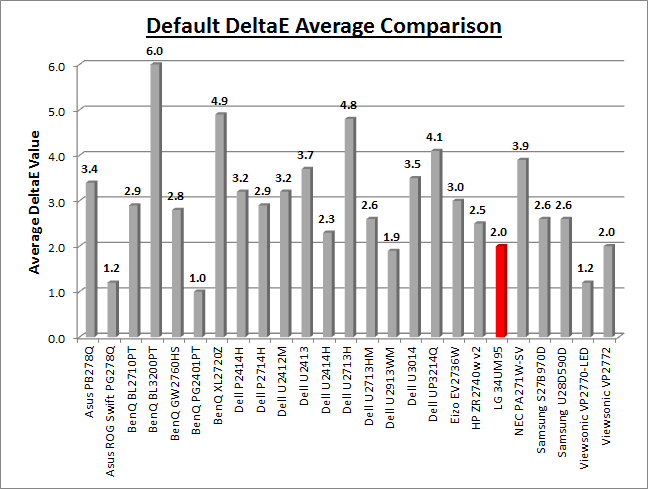
Default setup of the screen out of the box was
good with a gamma and white point within a few % deviance from the targets.
Colour accuracy was good at dE 2.0 average, and contrast ratio was strong at
over 1000:1. It
is too bright of course, but that's easy to turn down via the brightness
setting.
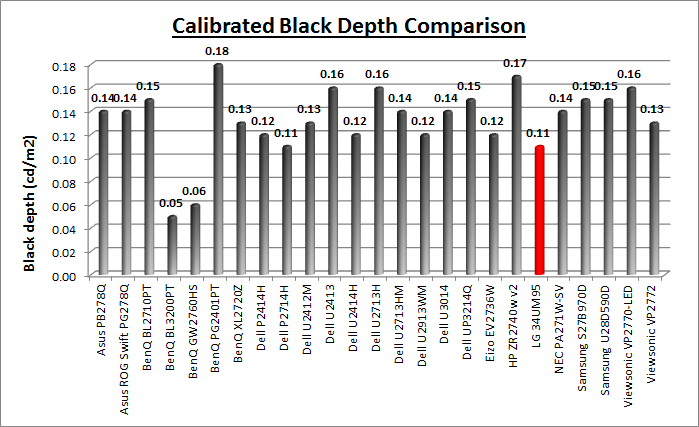

The display was strong when it came to black depth
and contrast ratio for an IPS-type panel. With a calibrated contrast ratio
(software calibration mode) of 1064:1 it was basically as high as any other IPS
variant we have tested. The Dell P2714H pipped it by 1, at 1064:1. This was a
very good performance for an IPS panel and we were pleased with the contrast
ratio offered. It can't compete with VA panel types which can reach over 2000:1
easily, and commonly up to 3000:1.

Support TFTCentral,
buy the LG 34UM95 using our affiliate link

Viewing Angles
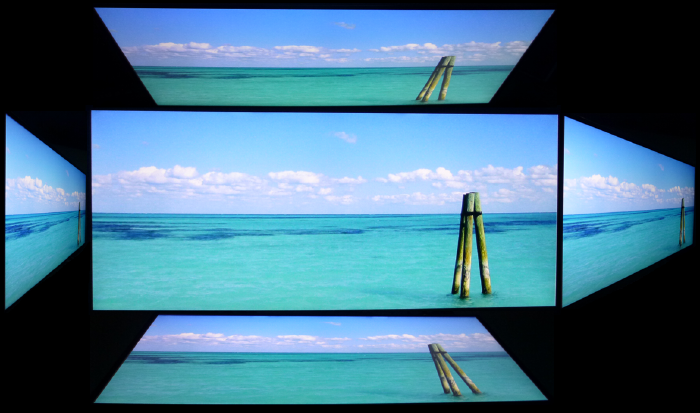
Above: Viewing
angles shown from front and side, and from above and below. Click for
larger image
Viewing angles of the 34UM95 were very good as you
would expect from an IPS panel. Horizontally there was very little colour tone
shift until wide angles past about 45° although the image did get darker from a
wide angle. Shifts were more noticeable in the vertical field but overall they
were good, with some darkening introduced as you get to a wide angle. The screen
offered the wide viewing angles of IPS technology and was free from the very
restrictive fields of view of TN Film panels, especially in the vertical plane.
It was also free of the off-centre contrast shift you see from VA panels and a
lot of the quite obvious gamma and colour tone shift you see from some of the
modern AMVA and PVA offerings. All as expected really from a modern IPS panel.
It should be noted that due to the very wide format of this screen you may
notice some contrast shifts as you glance towards the edges, depending on your
viewing position and your proximity to the screen.
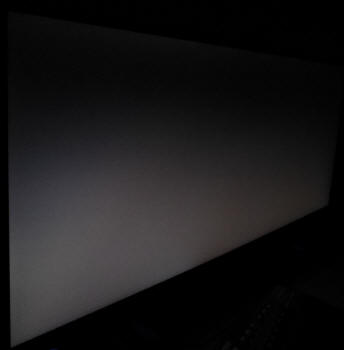
Above: View of an
all black screen from the side. Click for larger version
On a black image there is a characteristic white
glow when viewed from an angle, commonly referred to as IPS-glow. This is common
on most modern IPS panels and can be distracting to some users. If you view dark
content from a normal head-on viewing position, you can actually see this glow
as your eyes look towards the edges of the screen. Because of the sheer
horizontal size of this 34" panel, the glow towards the edges is more obvious
than on small screens, where there isn't such a long distance from your central
position to the edges. Some people may find this problematic if they are working
with a lot of dark content or solid colour patterns. In normal day to day uses,
office work, movies and games you couldn't really notice this unless you were
viewing darker content. If you move your viewing position back, which is
probably likely for movies and games, the effect reduces as you do not have such
an extreme angle from your eye position to the screen edges. This might be one
area where the new 34" curved monitors work a bit better, as the edges curve in
towards you a little and should reduce the IPS-glow effect somewhat.

Panel Uniformity
We wanted to test
here how uniform the brightness and colour temperature was across the screen, as well as identify any
leakage from the backlight in dark lighting conditions. Measurements of the luminance
and colour temperature were taken at 35 points across the panel on a pure
white background. The measurements for luminance were taken using BasICColor's calibration
software package, combined with an X-rite i1 Display Pro
colorimeter with a central point on the screen calibrated to 120 cd/m2. Measurements for colour temperature (white point) were taken using
BasICColor software and the i1 Pro spectrophotometer which can more accurately
measure the white point of different backlighting technologies. The below uniformity diagram shows the difference, as a percentage,
between the measurement recorded at each point on the screen, as compared with the
central reference point.
It is worth
noting that panel uniformity can vary from one screen to another, and can depend
on manufacturing lines, screen transport and other local factors. This is only a
guide of the uniformity of the sample screen we have for review.

Uniformity of Luminance
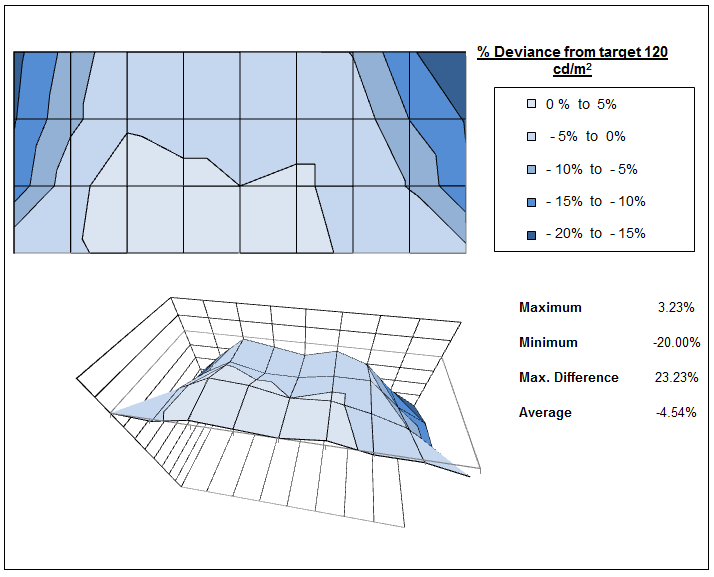
The luminance uniformity of the screen was
pretty good overall. There were some darker
regions in the upper corners where luminance dropped by a maximum of -20% to
100
cd/m2.
This was the worst case example and the actual regions were fairly small
where luminance dropped by a noticeable amount. Around 80% of the screen was
within a 10% deviance of the centrally calibrated point.

Backlight Leakage
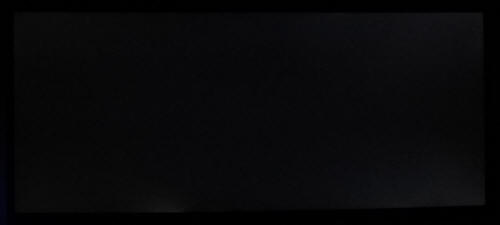
Above: All black screen in a darkened room. Click for larger version
As usual we also tested the screen with an all
black image and in a darkened room. A camera was used to capture the result. The
camera picked out a small area of leakage along the bottom left hand edge, and
some clouding from the right hand corners. Overall there wasn't anything too
severe but you could spot these brighter areas with the naked eye when looking
at a dark screen in a darkened room. In normal uses and normal ambient lighting
you couldn't really see any adverse effects to be honest. By the way the sample
we tested is a Rev 01, manufactured May 2014.

General and Office Applications

One of the key selling points of the 34UM95 is
it's high resolution and large screen size.
The 3440X1440 UltraWide QHD display offers a sharp but comfortable picture. Its
pixel area is about 1.8 times larger than an UltraWide Full HD 21:9 monitor, and
about 2.4 times larger than a Full HD 16:9 monitor. It provides an efficient
environment in using Microsoft Office programs showing 47 columns and 63 rows in
excel. Thankfully the high resolution is of a very comfortable size on the 34"
panel, with a 0.2325mm pixel pitch is is very comparable to a 27" 2560 x 1440
monitor (0.2331mm). This means you are basically getting a wider desktop to work
with, with a similar font size to a 27" model, and maintaining the same vertical
resolution as well. If you're coming from a lower resolution / larger pixel
pitch you may still find the fonts look quite small to start with, but like the
27" 1440p models out there you soon get used to it. We did feel it was far
more comfortable than recent 4k 28" screens when working at native resolution.

Side by side multi-tasking on this screen is
excellent. Splitting the screen in half is maybe not quite enough with the
horizontal resolution offered, but thankfully LG have included a handy solution.
With a 21:9 wide screen ratio, now you can multitask with 4 programs on one
screen at the same time. This 4-Screen Split feature (software provided by LG) conveniently divides your
screen from 2 to 4 customizable sub-screens of your preferred size, without any
overlapping of windows. Compatible with Mac, it provides 8 different screen
ratios, changeable by a single click, and increases not only your convenience
but also productivity. 4-Screen Split software requires DisplayPort or HDMI
connection with Windows XP/Vista/7/8 or Mac OS X 10.9(Mavericks).
The light AG coating of the IPS panel doesn't
produce any graininess to the image like some aggressive AG solutions can and so
white office backgrounds look clean and clear. The wide viewing angles of the
IPS panel technology provide stable images from different angles, meaning you
can use the screen if you want for colour critical work, photos etc. This panel
technology still offers the widest viewing angles and so is well-suited to
colour work. Some contrast shifts and IPS-glow may be evident because of the
very wide size of the display, as you glance towards the edges from a centrally
aligned position. That's hard to avoid on such a large desktop monitor from
close up, even with IPS technology.
The brightness
range of the screen was also very good, with the ability to offer a luminance
between a high 293 and a nice and low 54 cd/m2. This should mean
the screen is perfectly useable in a wide variety of ambient light conditions,
including darkened rooms. A setting of ~22 in the OSD brightness control should
return you a luminance close to 120 cd/m2. The
backlight regulation is controlled without the need for PWM at all, and so
the screen is flicker free. A definite pro for sensitive eyes and for comfortable
long-term viewing. There was no audible buzzing from the screen, even when
specifically looking for it using test images with a large amount of text at
once. The screen remains cool even during prolonged use. The screen offers two
'Reader' modes from the OSD menu which provide a couple of preset
brightness/temperatures which some people might find useful for extended text
work or reading.
There are some
extras provided as well with this screen. 2x USB 2.0 and 1x USB 3.0 ports are
included on the back. These aren't as easy to access as when they are located on
the side, but at least they are provided. There are also 2x 7W stereo speakers
built into the display which should be adequate for general office sounds, the
odd mp3 and Youtube video. A headphone port is also provided if needed. There
aren't any other extras light ambient light sensors, human motion sensors or
card readers here.
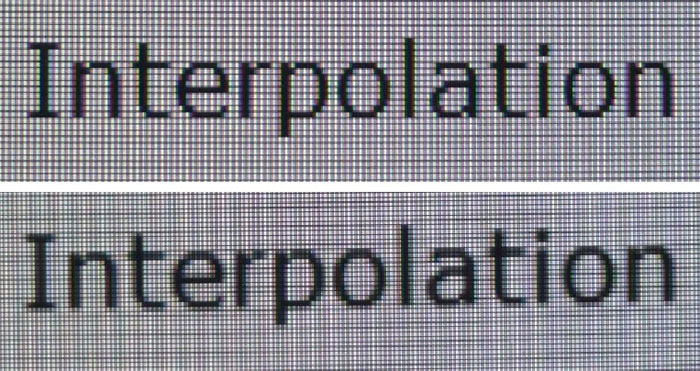
Above: photo of
text at 3440 x 1440 (top) and 2560 x 1080 (bottom)
The screen is designed to run at its native
resolution of 3440 x 1440 (4k) and at a 60Hz recommended refresh rate. However,
if you want you are able to run the screen outside of this resolution. We tested
the screen at a lower 2560 x 1080 resolution to see how the screen handles the
interpolation of the resolution, while maintaining the same aspect ratio of
21:9. At native resolution the text was very sharp, small but comfortable as we've already
discussed. When running at a 2560 x 1080 resolution the text is still pretty
sharp, with low levels of blurring. You do lose a lot of screen real-estate as
well, and it gives you a flavour of what the 34UM65 model must look like.

Responsiveness and Gaming
|
Quoted G2G Response Time |
5ms G2G |
|
Quoted ISO Response Time |
n/a |
|
Panel Manufacturer and
Technology |
LG.Display |
|
Panel Part |
LM340UW1-SSA1 |
|
Overdrive Used |
Yes |
|
Overdrive Control Available to
User |
'Response Time' |
|
Overdrive Settings |
Off, Low, Middle, High |
The 34UM95 is rated by LG as having a 5ms G2G response time
which indicates the panel uses
overdrive /
response time compensation (RTC) technology to boost pixel transitions
across grey to grey changes. There is user control over the overdrive impulse
within the OSD menu using the 'Response Time' option. The
part
being used is the
LG.Display LM340UW1-SSA1 AH-IPS panel. Have a read about response time in
our
specs section if you need additional information about this measurement.
We will first test the screen using our thorough
response time testing method. This uses an oscilloscope and photosensor to
measure the pixel response times across a series of different transitions, in
the full range from 0 (black) to 255 (white). This will give us a realistic view
of how the monitor performs in real life, as opposed to being reliant only on a
manufacturers spec. We can work out the response times for changing between many
different shades, calculate the maximum, minimum and average grey
to grey (G2G) response times, and provide an evaluation of any overshoot present
on the monitor.
We use an
ETC M526
oscilloscope for these measurements along with a custom photosensor device.
Have a read of
our response time measurement article for a full explanation of the testing methodology and reported
data.
Response Time Setting Comparison
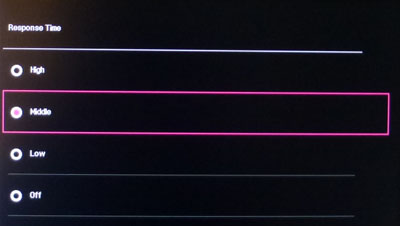
First of all we carried out a smaller sample set
of measurements in each of the four 'Response Time' settings. These, along with various
motion tests allowed us to quickly identify which was the optimum overdrive setting
for this screen.

First we tested the screen with the Response Time
option set to 'off'. Response times were slow with an average of 12.6ms G2G
being measured. There was no overshoot at all as overdrive was not being used,
but response times were too slow and it resulted in a lot of noticeable blurring
in practice. Rise times were particularly problematic with 15.4ms on average.

With the Response Time setting now switched up to the 'Low'
mode, response times had improved a little. The transitions remained free of any
overshoot still, and visible blurring was reduced a tad. Average G2G response
time was now measured at 10.7ms. Not great still, but heading in the right
direction.

The Middle setting improved response times again a
little, with average G2G being measured at 8.8ms now. Some of the slowest
transitions had been sped up nicely. For instance the troublesome 0-50
transition had basically halved from 18ms to 9.1ms at this setting. Some
overshoot was introduced as a result (16.7 %) but it was nothing too severe.
Most transitions showed no overshoot at all, so this response time setting had
improved on the 'off' and 'low' settings reasonably well, and without many
ill-effects.

The maximum 'High' setting resulted in some
improved response times again, with average G2G now dropping to a very respectable
7.2ms (for an IPS panel). However, more noticeable overshoot was introduced as a
result of the more aggressive overdrive impulse, to the extent that it became
noticeable in practice during motion tests and games. This mode is probably a
bit too aggressive although some people may prefer the overshoot trade-off. The
optimum response time mode seems to be the 'Middle' setting, where overshoot is
pretty much non-existent. Some people might want to experiment with the 'High'
setting as well, although we felt the overshoot was not really worth the
improvement in response times.

If we take some test photos using the PixPerAn
tool you can make some further visual comparisons between the overdrive
'Response Time' settings. With Response Time off the slow response times lead to a pronounced blur
to the moving image in practice which you can easily see. Turning the setting up
to Low makes minimal difference really, but switching up to the 'Middle' setting
brings about some positive changes. Blurring is reduced quite nicely and the
moving image looks sharper. There is still some blur visible of course but it's
better than 'off' or 'low'. The 'High' setting improves response times a little
more again, but some overshoot is visible on certain transitions. It's not that
noticeable in the PixPerAn tests but our oscilloscope revealed it was a problem
to a moderate degree. Worth trying out to see what you think, but we personally
felt 'middle' gave us a better balance.
More Detailed Measurements - Response Time =
Middle
Having established that the Response Time 'Middle' mode seemed to
offer the best response/overshoot balance we carried
out our normal wider range of measurements as shown below:
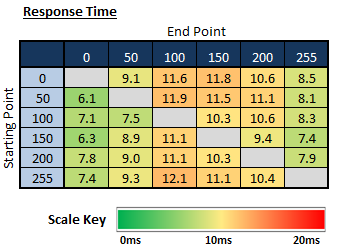
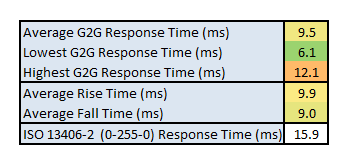
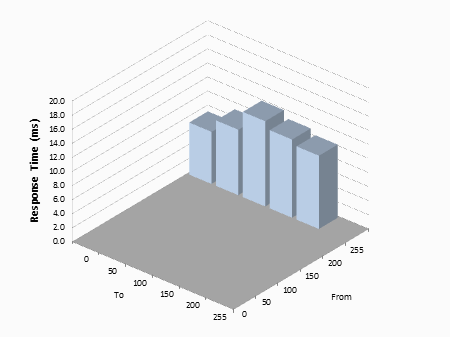
The average G2G response time was more accurately
measured at 9.5ms which was modest for an IPS panel overall. Some transitions
were faster at 6.1ms minimum, particularly when changing to black (x > 0). The
rise and fall time average was very similar and so pixel transition times were
fairly consistent across the board.
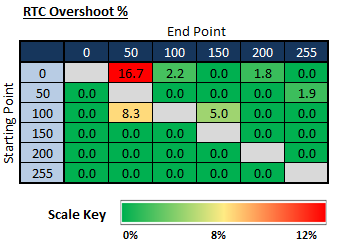
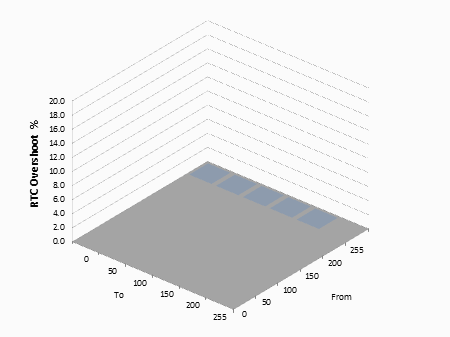
There was pretty much no overshoot as well in this
Response Time mode, with only a couple of transitions showing anything at all, and
even then, pretty low.
The overdrive impulse was being applied well and in a controlled fashion which was pleasing.
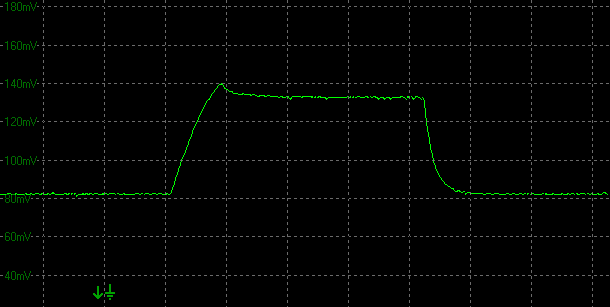
Transition: 0-50-0 (scale = 20ms)
The above gives an example of the highest
overshoot which was on the 0-50 transition (16.7%). Nothing really to worry
about in this Response Time mode.

Display Comparisons
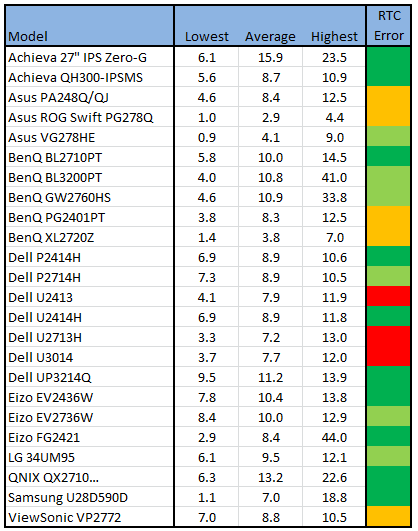
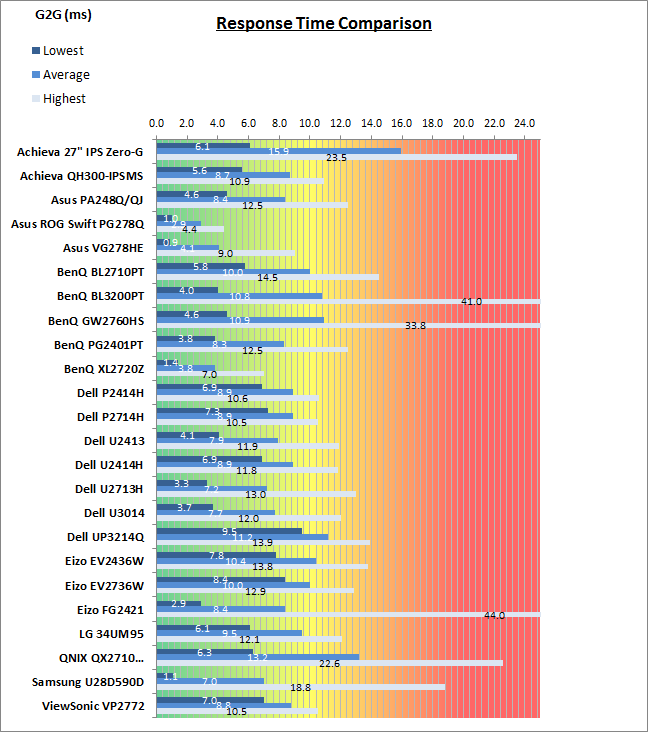
The above comparison table and graph shows you the
lowest, average and highest G2G response time measurement for each screen we
have tested with our oscilloscope system. There is also a colour coded mark next
to each screen in the table to indicate the RTC overshoot error, as the response
time figure alone doesn't tell the whole story.
The response time performance of the 34UM95 at the
'Middle' Response Time setting was good overall for an IPS-type panel. With an
average G2G response time of 9.5ms measured, it was only slightly behind some of
our reference IPS screens in these tests, like the Dell U2414H and Dell P2714H
(8.9ms) for example. Those models represented about as good as you can get from
modern IPS response times without introducing a significant amount of overshoot.
The LG 34UM95 was only slightly slower so that's a good performance. Some IPS
models can reach lower response times, like the Dell U2713H for instance (7.2ms)
but not without the cost of very high overshoot. Modern TN Film panels are still
much faster, reaching down to 2.9ms for instance in the example of the new Asus
ROG Swift PG278Q (with moderate overshoot).
The screen was also tested using the chase test in
PixPerAn for the following display comparisons. As a reminder, a series of
pictures are taken on the highest shutter speed and compared, with the best case
example shown on the left, and worst case example on the right. This should only
be used as a rough guide to comparative responsiveness but is handy for a
comparison between different screens and technologies as well as a means to
compare those screens we tested before the introduction of our oscilloscope
method.

34"
5ms
G2G LG.Display AH-IPS (Response Time = Middle)
In practice the LG 34UM95 performed best with
Response Time set to 'middle'. There were relatively low levels of motion blur
and no real ghosting visible. Thankfully no overshoot was detectable in nearly
all cases, with very few transitions affected according to our oscilloscope
tests as well.

34"
5ms
G2G LG.Display AH-IPS (Response Time = Middle)

28"
1ms
G2G Innolux TN Film (Overdrive = Faster)

27" 8ms G2G
LG.Display AH-IPS

27" 5ms G2G
Samsung PLS (Trace Free = 40)

27" 12ms G2G
Samsung PLS (Response Time = Advanced)
Firstly it is interesting to compare the 34UM95 to some of the other high
resolution panels we've tested. First of all there's a comparison against the
Samsung U28D590D with its 28" 3480 x 2160 res TN Film panel. As you might
expect, the LG isn't quite as fast as the Samsung in practice as the TN Film can
offer some very low response times. The Samsung showed a lower level of blur and
sharper image, but then it is a screen more aimed at gamers to be honest.
There is also a comparison against a range of
popular 27" 2560 x 1440 resolutions and IPS-type panels (IPS, PLS). The
Dell U2713HM
felt a little bit faster than the LG and eliminated
a lot of the visible blurring, but also remained free from overshoot which was
a bonus. The
Asus PB278Q was again
a little faster, and although it showed a little dark overshoot it was very slight. The
ViewSonic VP2770-LED was more comparable to the LG in visible blurring and
response times it seems.

34"
5ms
G2G LG.Display AH-IPS (Response Time = Middle)

27"
1ms
G2G AU Optronics TN Film @ 144Hz (OD = Normal)

27" 1ms G2G
AU Optronics TN Film + 144Hz (AMA = High)

23.5" 4ms G2G
Sharp MVA + 120Hz
We've also included a comparison above against
3 very fast 120Hz+ compatible screens we have tested. The other screens shown
here are all aimed primarily at gamers and have various features and extras
which make them more suitable overall for gaming.
Firstly there is a comparison against the
Asus ROG Swift PG278Q with its 144Hz refresh
rate and fast response time TN Film panel. This showed very fast pixel response times and smooth movement thanks to
its increased refresh rate. You are able to reduce the motion blur even more
through the use of the ULMB strobed backlight as well if you need to. In other
related areas this screen also supports NVIDIA's G-sync technology. There was
some slight overshoot noticeable on the Asus but nothing major.
Then there is a comparison against the
BenQ XL2720Z with another very fast TN Film panel and 144Hz refresh rate.
This showed very low levels of motion blur, but some dark overshoot was
introduced as a side-effect as you can see. This screen even includes a native
Blur Reduction mode to help eliminate further perceived motion blur.
Lastly there is the MVA based Eizo FG2421 screen
with a fast response time (especially for the panel technology being used) and
120Hz refresh rate support. There is also an additional 'Turbo 240' motion blur
reduction mode which really helps reduce the perceived motion blur in practice.
While these pixel response tests from PixPerAn
give one view of the performance of the panel, there is something else going on as well here which can't be picked out by the camera. All of these other
gaming models are
running at 120Hz (or higher) refresh rates, which allows for improved 120fps+ frame rates and
in some cases the support of
3D stereoscopic content as well. This can really help improve smoothness and
the overall gaming experience so these screens still have the edge when it comes
to fast gaming. Any additional extras to reduce perceived motion blur can also
have a real benefit in practical terms, and again not easy to pick out with this
camera method.

The overall gaming performance of the LG 34UM95
was good really. They've done a good job of offering a range of Response Time
settings for the user to experiment with. We felt the 'Middle' setting returned
the most favourable balance between response times and overshoot. At this
setting, the average 9.5ms G2G response time was respectable, and the absence of
any real overshoot was very pleasing. It wasn't quite as fast as a few other
IPS-type models we've tested, but wasn't far off. Obviously gamer-orientated TN
Film models are quite a bit faster, and their additional extras like blur
reduction modes, 120Hz+ refresh rates, G-sync etc make them far more suited to
serious gaming if that's your aim. At the moment though, the new 34" screen size
and ultra-wide aspect ratio are only available in IPS panels like this and that
in itself brings a new dimension for gaming in its own right. The IPS panel
offers wide viewing angles and stable colours so for gaming you can use the
screen from a variety of positions comfortably. The large screen area and wide
aspect ratio creates a very wide experience as well for games which can support
21:9 aspect ratio, and they really do feel immersive and involved as a result.
You can also comfortably use the screen from a further distance because of its
size if you want to. If you like the wide aspect ratio then this screen is
certainly capable of offering decent IPS-grade gaming performance.

Additional Gaming Features
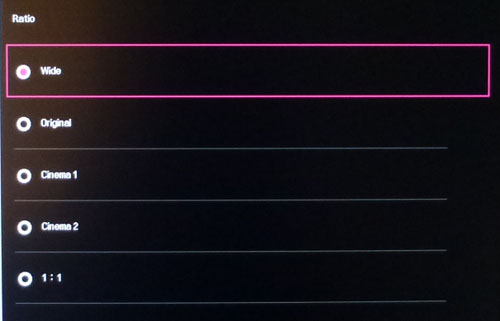
Aspect Ratio Control -
The 34UM95 has 5 options for
aspect ratio control through the OSD Easy Control > Ratio menu. There are options for
wide, original, cinema 1, cinema 2 and a 1:1 pixel mapping mode as shown below.
The following table describes their operation:
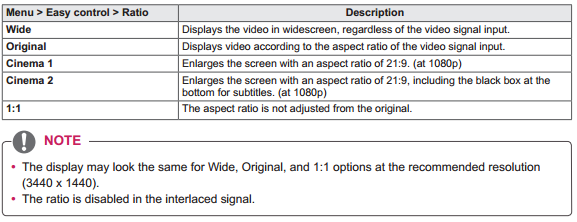
Preset Modes -
There is a specific 'game mode' available in the
OSD which appears to make the image much cooler and more blue. Probably easier
to set up the custom mode to your liking, although it's there if you want to try
it out.

Lag
We have written an in depth article about
input lag and the various measurement techniques which are used to evaluate
this aspect of a display. It's important to first of all understand the
different methods available and also what this lag means to you as an end-user.
Input Lag vs. Display Lag vs. Signal
Processing
To avoid confusion with different terminology we
will refer to this section of our reviews as just "lag" from now on, as there
are a few different aspects to consider, and different interpretations of the
term "input lag". We will consider the following points here as much as
possible. The overall "display lag" is the first, that being the delay between
the image being shown on the TFT display and that being shown on a CRT. This is
what many people will know as input lag and originally was the measure made to
explain why the image is a little behind when using a CRT. The older stopwatch
based methods were the common way to measure this in the past, but through
advanced studies have been shown to be quite inaccurate. As a result, more
advanced tools like SMTT provide a method to measure that delay between a TFT
and CRT while removing the inaccuracies of older stopwatch methods.
In reality that lag / delay is caused by a
combination of two things - the signal processing delay caused by the TFT
electronics / scaler, and the response time of the pixels themselves. Most
"input lag" measurements over the years have always been based on the overall
display lag (signal processing + response time) and indeed the SMTT tool is
based on this visual difference between a CRT and TFT and so measures the
overall display lag. In practice the signal processing is the element which
gives the feel of lag to the user, and the response time of course can
impact blurring, and overall image quality in moving scenes. As people become
more aware of lag as a possible issue, we are of course keen to try and
understand the split between the two as much as possible to give a complete
picture.
The signal processing element within that is quite
hard to identify without extremely high end equipment and very complicated
methods. In fact the studies by Thomas Thiemann which really kicked this whole
thing off were based on equipment worth >100,1000 Euro, requiring extremely high
bandwidths and very complicated methods to trigger the correct behaviour and
accurately measure the signal processing on its own. Other techniques which are
being used since are not conducted by Thomas (he is a freelance writer) or based
on this equipment or technique, and may also be subject to other errors or
inaccuracies based on our conversations with him since. It's very hard as a
result to produce a technique which will measure just the signal processing on
its own unfortunately. Many measurement techniques are also not explained and so
it is important to try and get a picture from various sources if possible to
make an informed judgement about a display overall.
For our tests we will continue to use the SMTT
tool to measure the overall "display lag". From there we can use our
oscilloscope system to measure the response time across a wide range of grey to
grey (G2G) transitions as recorded in our
response time
tests. Since SMTT will not include the full response time within its
measurements, after speaking with Thomas further about the situation we will
subtract half of the average G2G response time from the total display lag. This should allow us to give a good estimation of
how much of the overall lag is attributable to the signal processing element on
its own.
Lag Classification
To help in this section we will also introduce a broader classification system
for these results to help categorise each screen as one of the following levels:
-
Class 1)
Less than 16ms / 1 frame lag - should be fine for gamers, even at high levels
-
Class
2)
A lag of 16 -
32ms / One to two frames - moderate lag but should be fine for many gamers.
Caution advised for serious gaming and FPS
-
Class
3)
A lag of more
than 32ms / more than 2 frames - Some noticeable lag in daily usage, not
suitable for high end gaming
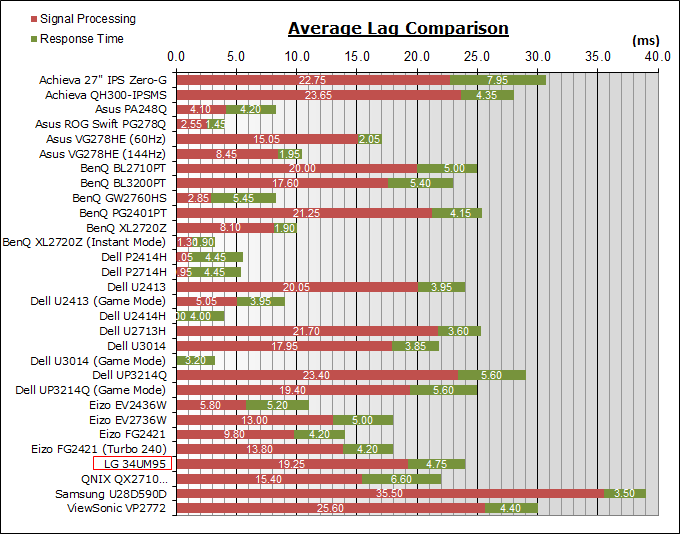
For the full reviews of the models compared here and the dates they were written
(and when screens were approximately released to the market), please see our
full
reviews index.
|
(Measurements in ms) |
|
|
Total Display Lag (SMTT
2) |
24.0 |
|
Pixel Response Time
Element |
4.75 |
|
Estimated Signal
Processing Lag |
19.25 |
|
Lag Classification |
2 |
|

Class 2 |
We have provided a comparison above against other
models we have tested to give an indication between screens. The screens
tested are split into two measurements which are
based on our overall display lag tests (using SMTT) and half the average G2G
response time, as measured by the oscilloscope. The response time is split from
the overall display lag and shown on the graph as the green bar. From there, the
signal processing (red bar) can be provided as a good estimation.
The screen showed a total average display lag of
24.0 ms as measured with SMTT 2. Taking into account half the average G2G
response time at 4.75ms (Middle Response Time setting), we can estimate that
there is ~19.25 ms of signal
processing lag on this screen. This is moderate and could present problems for
anyone sensitive to lag, or playing fast FPS games. On the other hand for a lot
of casual gamers it shouldn't present any real problem as it's 1.5 frames of
overall lag.

Movies and Video

The following summarises the screens performance
in video applications:
-
34"
screen size makes it a good option for an all-in-one multimedia screen,
and pushing towards the diagonal size of a lot of smaller end LCD TV's even.
-
21:9
aspect ratio is well suited to videos and particularly movies, leaving
smaller borders on DVD's and wide screen content at the top and bottom. The
ultra-wide aspect and size is well-suited to watching movies and really works
well.
-
3440 x
1440 resolution can support full 1080 HD resolution content.
-
Digital interface support HDCP for any encrypted and protected content
-
HDMI and DisplayPort
connections available. Nice to see HDMI connectivity included for modern DVD
players, Blu-ray, consoles etc.
-
Cables provided in the box
for HDMI and DisplayPort.
-
Light
AG coating provides clear images with no major graininess, and without the
unwanted reflections of a glossy solution.
-
Wide
brightness range adjustment possible from the display, including high maximum
luminance of ~293
cd/m2 and a good minimum
luminance of 54 cd/m2. This should afford you very good control for different
lighting conditions. Contrast ratio remains stable across most of that adjustment
range as well and is excellent for an IPS-type panel. Brightness regulation is controlled
without the need for PWM and so is flicker free at all settings which is
pleasing.
-
Black
depth and contrast ratio are excellent for an IPS-type panel at 1064:1 after
calibration. Detail in darker scenes should not be lost as a result.
-
There
is a specific 'cinema' preset mode available for movies or video in the OSD
which looked a little more yellow than our calibrated custom mode.
-
Good
pixel responsiveness which can handle fast moving scenes in movies without
issue. No real overshoot issues which is good news. Just stick to the 'Middle'
Response Time setting for optimum performance.
-
Wide viewing angles from IPS panel technology
meaning several people could view the screen at once comfortable and from a
whole host of different angles. White glow from an angle on black content is
also very low indeed which was pleasantly surprising.
-
Some
slight areas of backlight leakage but nothing major on our sample which is
good. Some uniformity variations may be visible on darker movie scenes in
darkened room conditions.
-
Very limited range of ergonomic adjustments
available from the stand, with only a basic tilt adjustment offered.
May present problems when viewing the screen from different positions.
-
Integrated stereo speakers offered on this model, may be ok for the odd video
clip but probably not for any movie viewing.
-
Decent
enough range of
hardware aspect ratio options available which is very useful for external
devices.
-
Picture By Picture (PbP) is available on
this model.

Conclusion
When we first plugged the 34UM95 in we were
surprised with just how big and wide the screen felt. However, when we connected
up a more common 27" 2560 x 1440 to write this conclusion at the end of our
testing we were amazed at how small and square it felt by comparison. It takes a
couple of days to get used to the size and shape of the LG but once you do it is
a nice screen to work and play with. We liked aspects of the styling, with the
silver trim, thin bezel design and rounded back casing. We were a bit
disappointed the stand wasn't a bit more flexible though as height adjustment is
really a must-have we feel for a modern desktop display. The connections and
extras provided were good though and LG had done a good job making this feel
like a high-end model. One area we didn't like was the operation and appearance
of the OSD menu. There were plenty of options available which was good, but we
found it slow and annoying to use on the most part.
The default factory setup was good overall with
only minor deviances from the desired targets. The contrast ratio was very
strong for this type of panel which was pleasing, and the use of a flicker free
backlight was a very welcome addition. Let's hope LG adopt that on more of their
screens. Having the ability to hardware calibrate the screen is certainly a
premium feature, and the software provided was easy to use and decent enough. We
were a bit disappointed with the LG calibrator device performance, although at
least it is cheap. You could obtain very good results with a third party device
and we were glad LG have at least allowed a wide variety of devices to be used
if you want to. Pixel response times were very good for an IPS panel as well,
with freedom from any significant overshoot if you pick the right mode. The IPS
panel certainly offered very good all-round performance here and we were
impressed.
The ultra-wide format lent itself very well to a
lot of uses. Split screen working, including LG's 4 screen split software was
very usable on a screen this size and with this high a resolution. Gaming felt
immersive and gave you a very wide field of view and many people will probably
like the unusual but enjoyable format. Movies of course benefited from the
"cinema style" format and looked very good. We expect to see more large and wide
format screens appear and look forward to also testing the new curved 34" models
when they arrive. In the mean time, the LG 34UM95 makes an impressive large and
very wide screen, with a lot of good performance to back it up.
If you appreciate the review
and enjoy reading and like our work, we would welcome a
donation
to the site to help us continue to make quality and detailed reviews for you.
|
Pros |
Cons |
|
Massive screen size, high
resolution and comfortable pixel pitch |
Limited ergonomic adjustments
offered |
|
Good factory calibration and
default setup |
OSD is slow, clunky and a bit
frustrating to use |
|
Effective hardware calibration
function |
LG calibrator not that
reliable or versatile |

Support TFTCentral,
buy the LG 34UM95 using our affiliate link